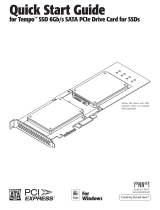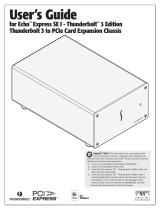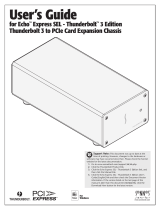
6. Insert the kit into the Echo Express III-R rackmount enclosure,
followed by the inner assembly (Figure 6). Secure the inner assembly
to the enclosure using the four screws you removed previously. Secure
the kit to the enclosure using five of the six screws you removed
previously, as shown.
7. Install the Echo Express III-R into its rack now.
8. Connect the included Thunderbolt cable between either Thunderbolt
port on the Echo chassis and a Thunderbolt port on your computer,
or other Thunderbolt device in the chain connected to the computer
(Figure 7). Secure the retainer clip to the chassis if you attached it.
If you are daisy chaining additional Thunderbolt devices, connect
another Thunderbolt cable between the downstream device and the
open Thunderbolt port on the Echo chassis.
9. Connect interface cables between devices, PCIe cards, and computer
as necessary.
10. Connect the included power cords between a wall outlet or power strip
and the Echo chassis’ power socket and the kit’s power socket. Note that
the power indicator on the Echo Express III-R will not light until the
computer, and any other Thunderbolt device connected between it and
the Echo chassis, is powered on.
11. Return to Chapter 4 – Verify Connections Using OS X System Information
in the Echo Express III-R User’s Guide to complete setup.
Chapter 3 – Installation Steps
6
Figure 6
Support Note: Sonnet’s ThunderLok™ Thunderbolt connector
retainer clip secures the included Thunderbolt cable to the Echo
chassis to prevent accidental disconnects. Although it is compatible with
other copper Thunderbolt cables like Apple’s, it is not compatible with
optical Thunderbolt cables.
To attach the clip to the cable, remove them from their packaging, and then
insert the connector into the connector clip as shown (Figure 7). Note that
the connector will pass all the way through the clip; when you connect the
cable to the chassis, the clip will secure the cable.
Figure 7

























